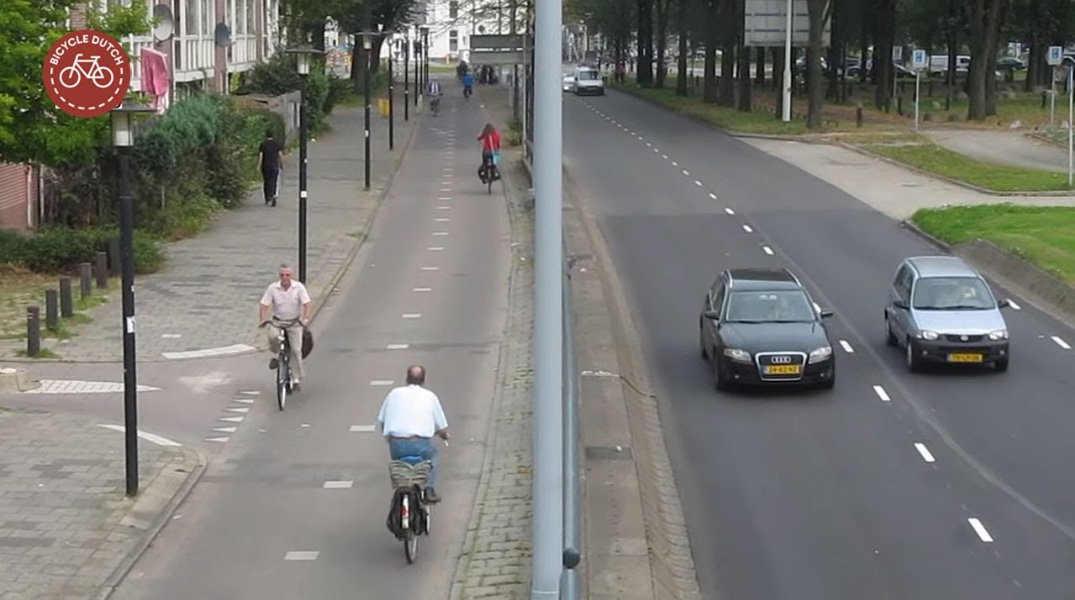The Friends appreciate and encourage community input that helps lead to viable and safe solutions.

Community member Kurt Kaminer shared this opinion on the best course forward in the multiple-use vs. single-use path discourse.
During DTPW public meetings and outreach, a multiple-use path design for the Commodore Trail along South Bayshore Drive is the design variant that received overwhelming public support.
As a great supporter of separated, Dutch-inspired protected bicycle infrastructure in Miami, I feel it necessary to share the following thoughts about why the multiple-use path – though inherently flawed as currently envisioned – is, at present, the only option of the two presented by DTPW that can help encourage the mode shift we so desperately need in Miami.
I should point out that in principle, I do agree with the concern brought forth by advocates of fully separated bike lanes—Bicycle traffic should not be grouped with pedestrian traffic. Just as not every rider is comfortable with the speed differential of a car whizzing by, neither are many pedestrians comfortable with the speed differential of a bicycle rider whizzing by. Every effort should be made to separate pedestrian and bicycle traffic on any modern infrastructure, whether by a simple strip of grass between paths or alternate elevations, as in this utterly flawless Dutch example designed to seamlessly accommodate all three modes:

However, I also recognize that there is no future in unprotected, painted bike lanes on the roadway – the alternative to the MUP proposal. I’m sure you’ve heard the phrase “Paint is not protection” – indeed, the US has been grappling with this safety issue for 30+ years for lack of protected bike lanes.
More importantly, safety is only part of the picture that makes the MUP the better choice of the two: Painted bike lanes also fail to provide the perception of safety that’s necessary to convince people that a bicycle trip is a viable transportation option.
As DTPW Director Cleckley has pointed out via NHTSA data, 51-56% of riders – the largest single demographic of riders – belong to the “Interested but Concerned” demographic; the kind that need protected bike lanes and MUPs. As such, we shouldn’t be building bicycle infrastructure in the year 2023 that serves only the “Strong and Fearless” 4-7%, even if their risk tolerance means they have a more organized voice in Miami.

The way I see it, if Public Works will not commit to a reduction of turn lane space at this time (which would provide the Commodore the necessary room to have a separated, protected bike lane and sidewalk for a majority of its length), the multiple use path – even with its inherent flaws – remains a better option for the future of equitable cycling in Miami than a pair of unprotected bike lanes.
Does this mean the County’s section of the Commodore Trail might, in less than a decade, be up for yet another redesign? Absolutely. Is this an efficient use of resources? No, but it is likely the only way to increase ridership to the point where the data justifies redistribution of space. Will there be conflicts? Yes, but those ped vs. bike conflicts will pose far less risk and danger than bike vs. automotive.
I should also point out: I have it on good authority that the upcoming MUTCD revisions this fall will include guidance that allows roadways with separated bicycle facilities to also utilize signage that legalizes vehicular cycling on the parallel automotive street.
Per these upcoming changes, Bayshore Drive with a separated MUP can simultaneously carry “Bicycles may use full lane” signs (MUTCD R4-11) along the roadway, providing an option for both demographics of riders. This should appease (and correct) road cyclists who claim they’re going to get marginalized onto an MUP.
In short: While the MUP is not a perfect solution, it’s a lot less flawed than painted bike lanes and will do much more to encourage mode shift and justify further improvements to bicycle facilities in Miami in the coming decade. Please keep this in mind as the project moves forward and the inevitable objections come forth.
Sincerely,
Kurt Kaminer
Miami, Florida USA


I agree with Mr. Kaminer – however having utilized Kennedy park for years as a pedestrian – i have often just missed being RUN OVER by cyclists who have no intention of following the rules of the road ie lights, signs and mostly not running over pedestrians!
The 4-7% or riders are NOT the majority and the majority need to be considered first.
Also the green areas are of no use in a city which is overflowing with new people – use that space for either motorists or MUA.
After many years of running the trail, I will tell you without hesitation, high risk bikers especially and low risk family bikers alike expect pedestrians to MOVE OUT of the way (ring, ring). Accidents involving bikes and pedestrians while less likely to cause serious injury than a car or truck and a bike or pedestrian, can and do cause injury, sometimes serious injury and pushing these two flows together will undoubtedly increase the frequency of accidents on The Trail. Isn’t a safer trail the goal here? I am adamantly opposed to a wider multi use path without lanes for bikers and pedestrians and feel strongly a change of elevation or some other narrow yet effective barrier such as flexible posts or armadillos need to be incorporated into the design from the get-go.
There’s definately a lot to learn about this subject. I really
like all the points you have made.